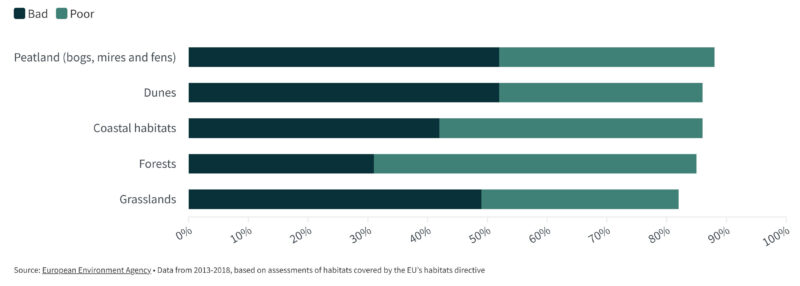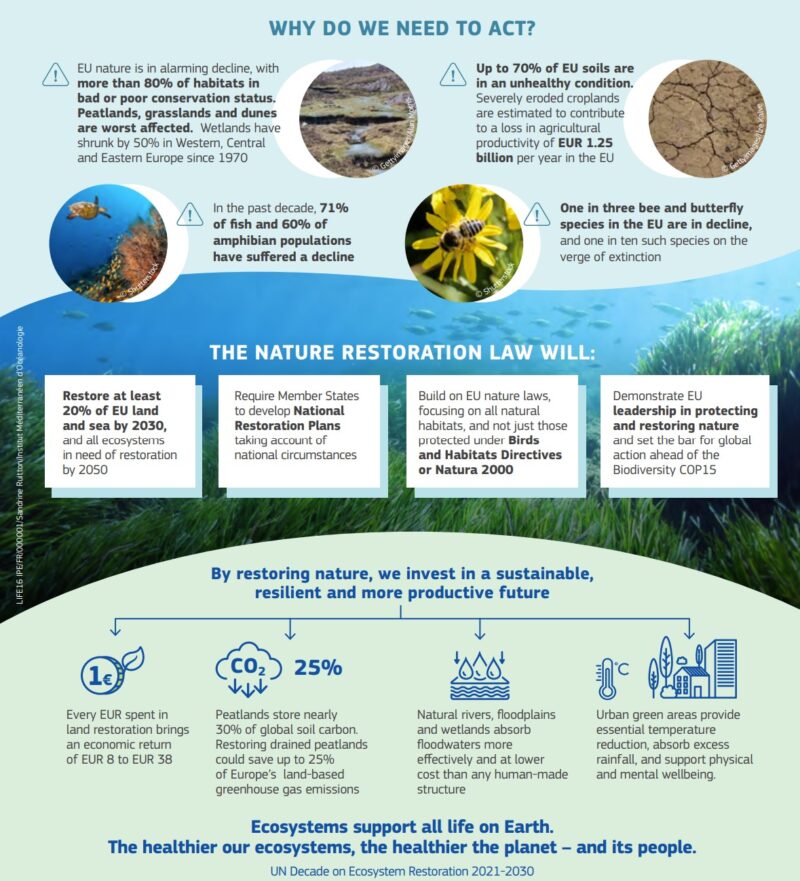What can we expect after the stop on 25 March?
The European Council puts a worrying brake on the law. Now approval becomes more uncertain and is postponed to “a date to be set”. We talked about it with Giulia Testa from European Young Rewilders.

More than 80 per cent of European habitats are in poor status. This is the starting point for the ambitious path of the European Nature Restoration Law. And it is not a “mere” matter of restoring degraded ecosystems, it is also an urgent economic issue. The EU estimates that every euro invested in environmental restoration adds from 4 to 38 euros in benefits in terms of ecosystem services: limiting global warming, pollinating crops, food security, protection from floods, just to mention a few of the most current environmental emergencies.

The agreement on the Nature Restoration Law was adopted by the European Parliament last 27 February, with 329 votes in favour, 275 against and 24 abstentions. After Parliament’s approval, it was essential that the member states confirm their commitment. However, contrary to expectations, the Council decided not to put the vote on the agenda of the 25 March meeting.
What was supposed to be only a formal step ended up being a defeat.
The U-turn by Hungary was decisive. A few days before the meeting it had announced its opposition to the law, despite years of negotiations and previous support.
This announcement overturns everything, as it lacks a qualified majority. In fact, Hungary is not the only country to oppose the Nature Restoration Law. Italy, Sweden, Poland and the Netherlands have always been against it, while Austria, Belgium and Finland have always abstained.
What happens now?
Belgium, as EU Council Presidency, has committed itself to a new vote ”’soon”. But for this to succeed, it is necessary for one of the opposing or abstaining countries to change its mind. The change of EU Council Presidency in July Complicates the framework, as it will be Hungary’s turn. A scenario that is certainly not favourable for the path of the Law. Further uncertainty comes from the European Parliament elections in June. If the Council does not reach an agreement now, the text may have to be revised again, all with a new composition of the Parliament.

We spoke about this “obstacle course” with Giulia Testa, European biodiversity law specialist and coordinator of European Young Rewilders, part of the coalition that brings together the main youth organisations concerned with biodiversity at European level.
“Our disappointment has grown over the long negotiations, which, year after year, have substantially weakened the impact of the law, as well as causing its serious delay. Today its very existence is being called into question.”
The youth organisations – Generation Climate Europe, European Young Rewilders, Youth & Environment Europe network, Global Youth Biodiversity Network Europe – which have been covering the process since the beginning, had already expressed their concerns about the first, more ambitious text of the Law. In an early position paper in 2021, they objected to the absence of immediate prescriptions for implementation, a limitation that threatened the very cardinal principle of their position: intergenerational justice.
“Not only we, young people, have to cope with the degradation that we have inherited from previous generations, which we will have to live with for a long time to come, but we also have to watch a continuous postponement and downgrading of counteracting goals, which will force us to do the bulk of the work later on”, Giulia stated.
So now young Europeans risk to see their expectations further disappointed.

We ask her: is restoring at least 30 per cent of degraded habitats in EU lands and seas by 2030 and 90 per cent by 2050 still a feasible goal?
“We need this law, despite its limitations. To say that it will change the fate of the environment in Europe is very optimistic, because it does not address the threats in a systemic way, but more than 30 years have passed since the Habitats Directive and now we need to take a step forward. Fifteen years ago no one knew what Nature Restoration was, today, at least, we are talking about it at the regulatory level”, Giulia pointed out.
Whatever the outcome of this process, the bitter remark remains that young people have never been considered important stakeholders and have never been granted the opportunity to participate effectively in the development of restoration plans. The organisations, representing more than 20 million young Europeans, came back to claim their role again in 2023, as they strongly report in their latest position statement:
“We believe that young people play a crucial role in nature restoration and should be empowered to act. Not only does nature restoration depend on the effective involvement of young people, but our future also depends on restoring nature. Nature restoration is a youth issue, and youth are central to championing nature restoration on a long term”.
Sources to explore
- The Law
- FAQs
- Youth Position on EU Nature Restoration Law (November 2021)
- Youth Position on EU Nature Restoration Regulation (March 2023)